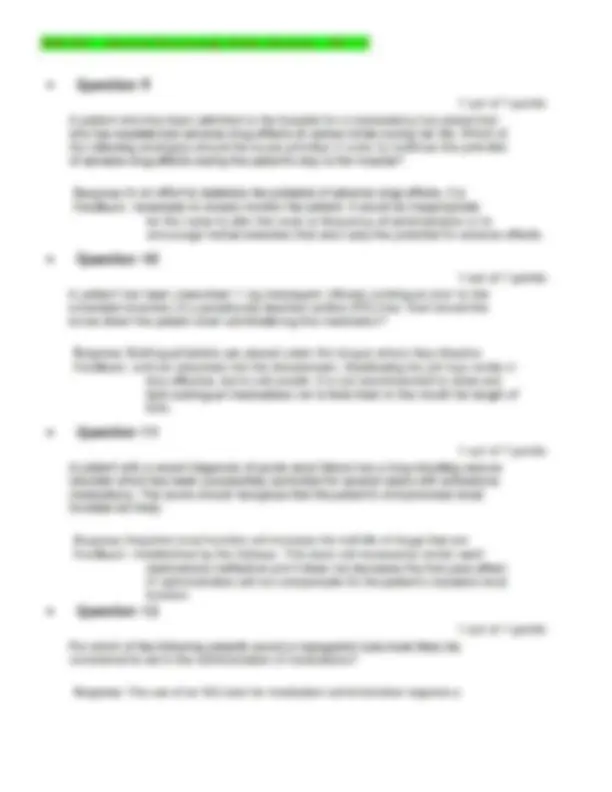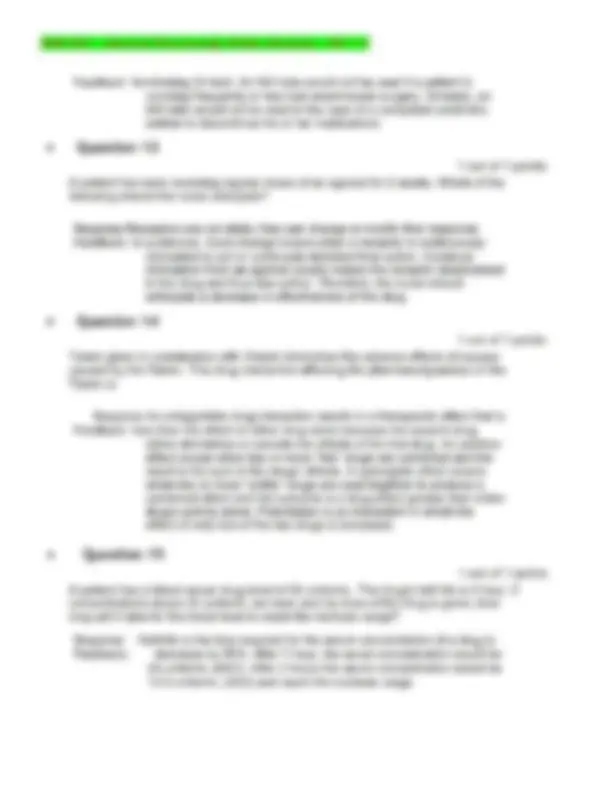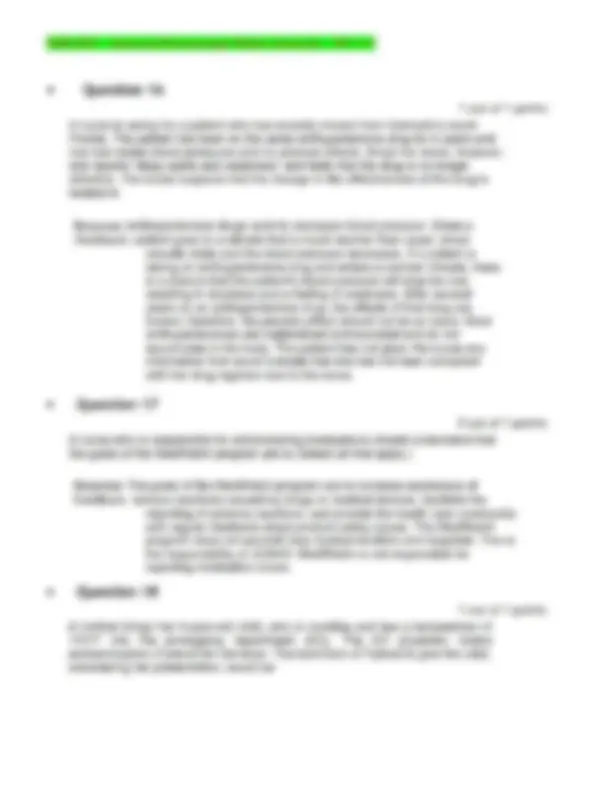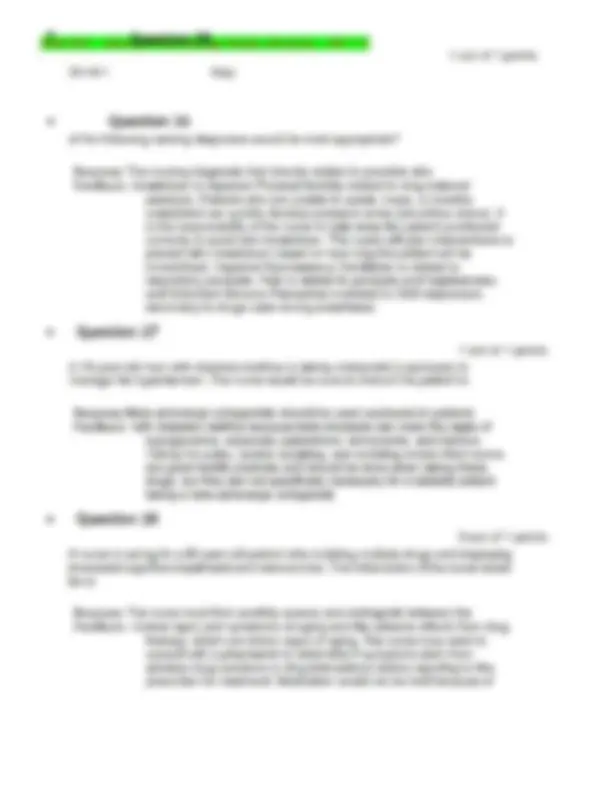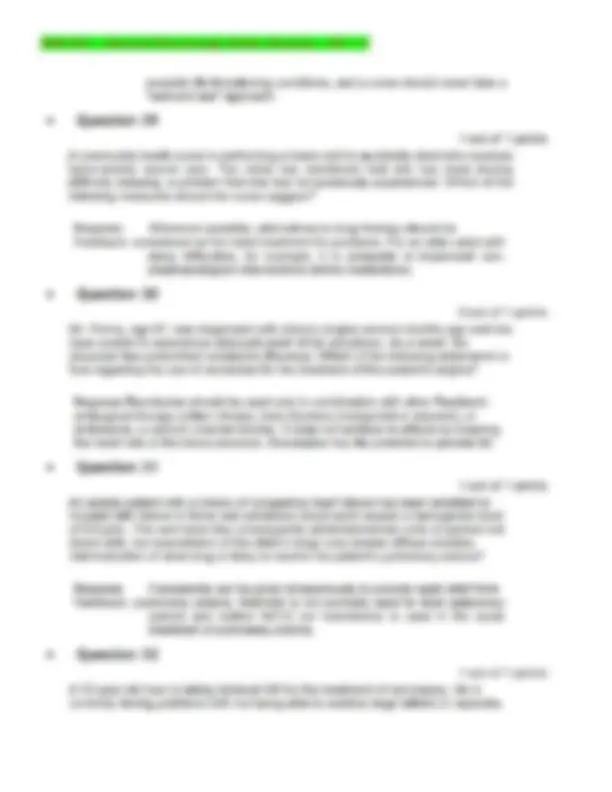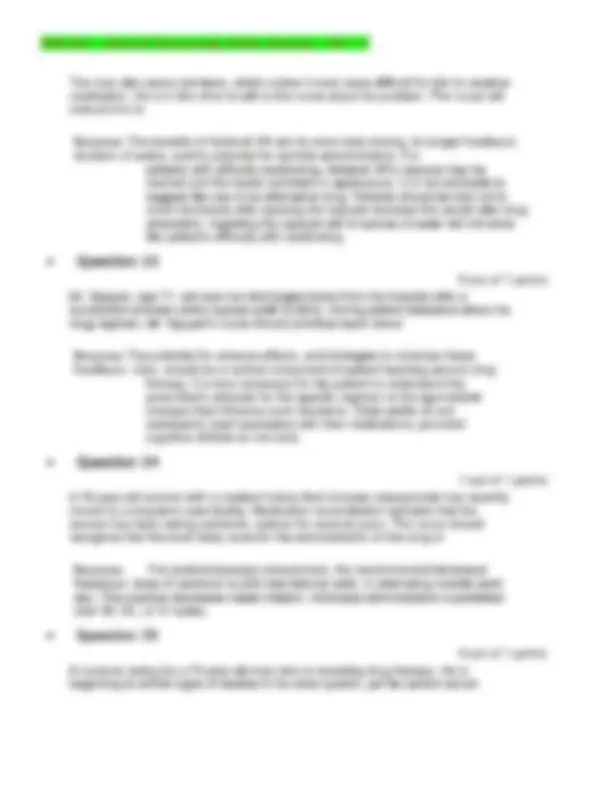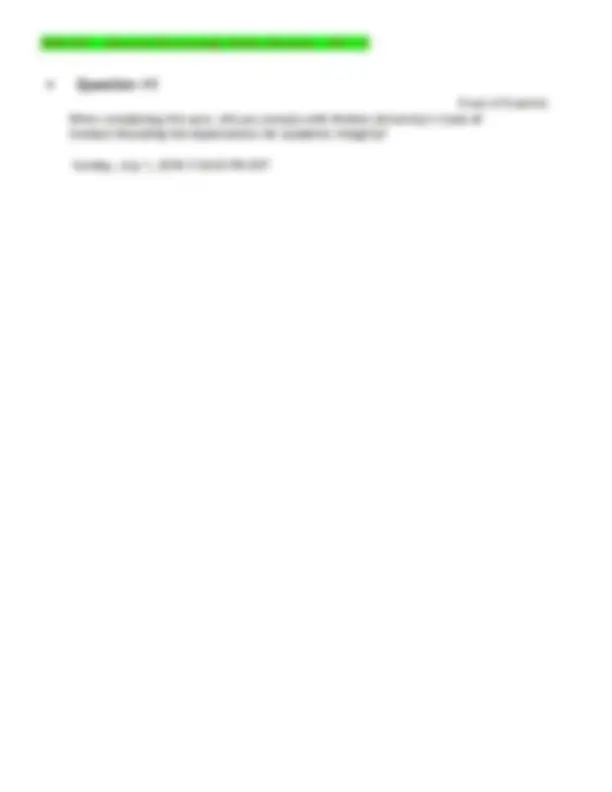Partial preview of the text
Download NURS 6521 - Advanced Pharmacology-Walden University – Week 1 Version 1. and more Exams Pharmacology in PDF only on Docsity!
* Question 1 1 out of 1 points Tylenol 325 mg/tablet, patient needs 650 mg; how many tables should patient take? * Question 2 0 out of 1 points A 60-year-old African-American man lives with a number of chronic health problems. Genetic factors are likely to influence his etiology and/or treatment of Response The incidence of hypertension is significantly higher among African- Feedback: Americans than other ethnic groups. As well, African Americans respond to some antihypertensive drugs differently than whites. e Question 3 0 out of 1 points Which of the following statements best defines how a chemical becomes termed a drug? Response — Even though all the responses are correct, a chemical must undergo Feedback: a series of tests to determine its therapeutic value and efficacy without severe toxicity or damaging properties before it is termed a drug. Test results are reported to the FDA, which may or may not give approval. e Question 4 1 out of 1 points The nurse's assessment of a community-dwelling adult suggests that the client may have drug allergies that have not been previously documented. What statement by the client would confirm this? Response True allergic reactions include formation of rash or hives, itching, Feedback: redness, swelling, difficulty breathing, and anaphylactic shock. Nausea and vomiting, however, are adverse effects of drug therapy. Similarly, an unsafe drop in blood pressure and gastric bleeding from aspirin use are adverse drug effects, not allergic reactions. e Question 5 1 out of 1 points In light of her recent high blood pressure readings, a patient has been started ona thiazide diuretic and metoprolol (Lopressor), which is a beta-adrenergic blocker. What is the most likely rationale for using two medications to address the patient's hypertension? Response A synergistic effect occurs when two or more “unlike” drugs (in terms Feedback: of therapeutic effect or mechanism of action) are used together to produce a combined effect, and the outcome is a drug effect greater than either drug's activity alone. As a result, the patient's hypertension may be better treated than with a single drug. This does not necessarily reduce the risk of adverse reactions or increase compliance with the regimen. e Question 6 1 out of 1 points Which of the following affects drug distribution throughout the body? Response Both protein binding and altered pH of extracellular fluids affect drug Feedback: distribution. The presence of food in the gastrointestinal tract affects drug absorption, whereas an increase in hepatic enzymes affects drug metabolism. High blood levels are not known to affect drug pharmacokinetics. ¢ §=Question 7 0 out of 1 points A nurse is discussing with a patient the efficacy of a drug that his physician has suggested, and he begin taking. Efficacy of a drug means which of the following? Response Efficacy indicates how well a drug produces its desired effect. Feedback: Different drugs have different strengths of attraction or affinity for receptor sites. A drug's ability to stimulate its receptor is called its intrinsic activity, and the amount of a drug that must be given to produce a particular response is called the potency of a drug. e Question 8 1 out of 1 points A nurse is caring for a postsurgical patient who has small tortuous veins and had a difficult IV insertion. The patient is now receiving IV medications on a regular basis. What is the best nursing intervention to minimize the adverse effects of this drug therapy? Response Because the patient has small tortuous veins and had a difficult IV Feedback: insertion, the patient is at high risk for infiltration of the IV site. Recording baseline vital signs or blood sugar level is an important nursing action, but not specific to lV administration of any drug. The patient is not known to take anticoagulants; so unless indicated, the nurse is not required to monitor the patient's bleeding time. Feedback: functioning Gl tract. An NG tube would not be used if a patient is vomiting frequently or has had recent bowel surgery. Similarly, an NG tube would not be used in the case of a competent adult who wishes to discontinue his or her medications. e Question 13 1 out of 1 points A patient has been receiving regular doses of an agonist for 2 weeks. Which of the following should the nurse anticipate? Response Receptors are not static; they can change or modify their response Feedback: to a stimulus. Such change occurs when a receptor is continuously stimulated to act or continually inhibited from action. Continual stimulation from an agonist usually makes the receptor desensitized to the drug and thus less active. Therefore, the nurse should anticipate a decrease in effectiveness of the drug. e = Question 14 1 out of 1 points Talwin given in combination with Vistaril diminishes the adverse effects of nausea caused by the Talwin. This drug interaction affecting the pharmacodynamics of the Talwin is Response An antagonistic drug interaction results in a therapeutic effect that is Feedback: less than the effect of either drug alone because the second drug either diminishes or cancels the effects of the first drug. An additive effect occurs when two or more “like” drugs are combined and the result is the sum of the drugs' effects. A synergistic effect occurs when two or more “unlike” drugs are used together to produce a combined effect and the outcome is a drug effect greater than either drug's activity alone. Potentiation is an interaction in which the effect of only one of the two drugs is increased. ° Question 15 1 out of 1 points A patient has a blood serum drug level of 50 units/mL. The drug's half-life is 1 hour. If concentrations above 25 units/mL are toxic and no more of the drug is given, how long will it take for the blood level to reach the nontoxic range? Response Half-life is the time required for the serum concentration of a drug to Feedback: decrease by 50%. After 1 hour, the serum concentration would be 25 units/mL (50/2). After 2 hours the serum concentration would be 12.5 units/mL (25/2) and reach the nontoxic range. e Question 16 1 out of 1 points A nurse is caring for a patient who has recently moved from Vermont to south Florida. The patient has been on the same antihypertensive drug for 6 years and has had stable blood pressures and no adverse effects. Since her move, however, she reports “dizzy spells and weakness” and feels that the drug is no longer effective. The nurse suspects that the change in the effectiveness of the drug is related to Response Antihypertensive drugs work to decrease blood pressure. When a Feedback: patient goes to a climate that is much warmer than usual, blood vessels dilate and the blood pressure decreases. If a patient is taking an antihypertensive drug and enters a warmer climate, there is a chance that the patient's blood pressure will drop too low, resulting in dizziness and a feeling of weakness. After several years on an antihypertensive drug, the effects of that drug are known; therefore, the placebo effect should not be an issue. Most antihypertensives are metabolized and excreted and do not accumulate in the body. The patient has not given the nurse any information that would indicate that she has not been compliant with her drug regimen due to the move. e Question 17 0 out of 1 points A nurse who is responsible for administering medications should understand that the goals of the MedWatch program are to (Select all that apply.) Response The goals of the MedWatch program are to increase awareness of Feedback: serious reactions caused by drugs or medical devices, facilitate the reporting of adverse reactions, and provide the health care community with regular feedback about product safety issues. The MedWatch program does not accredit new medical facilities and hospitals. This is the responsibility of JCAHO. MedWatch is not responsible for reporting medication errors. e Question 18 1 out of 1 points A mother brings her 4-year-old child, who is vomiting and has a temperature of 103°F into the emergency department (ED). The ED physician orders acetaminophen (Tylenol) for the fever. The best form of Tylenol to give the child, considering her presentation, would be On the 1 a.m. rounds, the nurse finds a patient awake and frustrated that she cannot go to sleep. The nurse administers an ordered hypnotic to help the patient sleep. Two hours later, the nurse finds the patient out of bed, full of energy and cleaning her room. The nurse evaluates the patient's response to the hypnotic as Response An idiosyncratic response is an unusual or opposite effect of what is Feedback: intended. A response of this nature is related to a person's unique response to a drug rather than to the dose of a drug. An allergic reaction is an immune system response. A synergistic effect occurs when two or more “unlike” drugs are used together to produce a combined effect and the outcome is a drug effect greater than either drug's activity alone. A teratogenic effect is a physical defect in the developing fetus caused by a drug or a vaccine that the mother took during pregnancy. ° Question 23 1 out of ' points In order to promote therapeutic drug effects, the nurse should always encourage patients to Response Taking a drug at the appropriate time will help the patient maintain Feedback: therapeutic drug levels. Not all medications should be taken with food, which can alter the absorption of some drugs. A patient should never increase or decrease a medication dosage without checking with the prescriber. Alternative therapy should only be used if the patient has discussed the therapy with the prescriber and they are in agreement. * Question 24 1 out of 1 points A patient with a variety of chronic health problems is being seen by her nurse practitioner, who is currently reviewing the patient's medication regimen. Which of the patient's medications should prompt the nurse to teach her to avoid drinking grapefruit juice? Response Metabolism of many varied drugs such as calcium channel blockers Feedback: (used to treat hypertension), statins (used to lower blood lipid levels), and antihistamines (used to prevent allergic reactions) is affected by grapefruit juice. ‘ out of 1 points A 90-year-old frail, elderly woman has arrived at the emergency department with a broken hip and in acute respiratory distress. Succinylcholine will be used because of the need for rapid endotracheal intubation, and then the woman will be sent to surgery. Due to the woman's frail condition, she is at risk for skin breakdown. Which 30 ml = tbsp 1 out of 1 points ° Question 26 of the following nursing diagnoses would be most appropriate? Response The nursing diagnosis that directly relates to possible skin Feedback: breakdown is Impaired Physical Mobility related to drug-induced paralysis. Patients who are unable to speak, move, or breathe unassisted can quickly develop pressure sores (decubitus ulcers). It is the responsibility of the nurse to help keep the patient positioned correctly to avoid skin breakdown. The nurse will plan interventions to prevent skin breakdown based on how long the patient will be immobilized. Impaired Spontaneous Ventilation is related to respiratory paralysis. Fear is related to paralysis and helplessness, and Disturbed Sensory Perception is related to CNS depression secondary to drugs used during anesthesia. e Question 27 1 out of 1 points A 70-year-old man with diabetes mellitus is taking metoprolol (Lopressor) to manage his hypertension. The nurse would be sure to instruct the patient to Response Beta-adrenergic antagonists should be used cautiously in patients Feedback: with diabetes mellitus because beta blockade can mask the signs of hypoglycemia, especially palpitations, tachycardia, and tremors. Taking his pulse, weekly weighing, and avoiding smoke-filled rooms are good health practices and should be done when taking these drugs, but they are not specifically necessary for a diabetic patient taking a beta-adrenergic antagonist. e Question 28 0 out of 1 points A nurse is caring for a 92-year-old patient who is taking multiple drugs and displaying increased cognitive impairment and memory loss. The initial action of the nurse would be to Response The nurse must first carefully assess and distinguish between the Feedback: normal signs and symptoms of aging and the adverse effects from drug therapy, which can mimic signs of aging. The nurse may need to consult with a pharmacist to determine if symptoms stem from adverse drug reactions or drug interactions before reporting to the prescriber for treatment. Medication would not be held because of The man also wears dentures, which makes it even more difficult for him to swallow medication. He is in the clinic to talk to the nurse about his problem. The nurse will instruct him to Response The benefits of Adderall XR are its once-daily dosing, its longer Feedback: duration of action, and its potential for sprinkle administration. For patients with difficulty swallowing, Adderall XR's capsule may be opened and the beads sprinkled in applesauce. It is not advisable to suggest the use of an alternative drug. Patients should be told not to crush the beads after opening the capsule because this would alter drug absorption. Ingesting the capsule with 8 ounces of water will not solve the patient's difficulty with swallowing. e Question 33 0 out of 1 points Mr. Nguyen, age 71, will soon be discharged home from the hospital after a successful coronary artery bypass graft (CABG). During patient education about his drug regimen, Mr. Nguyen's nurse should prioritize teach about Response The potential for adverse effects, and strategies to minimize these Feedback: risks, should be a central component of patient teaching around drug therapy. It is less necessary for the patient to understand the prescriber’s rationale for the specific regimen or the age-related changes that influence such decisions. Older adults do not necessarily need assistance with their medications, provided cognitive deficits do not exist. e Question 34 1 out of 1 points A 79-year-old woman with a medical history that includes osteoporosis has recently moved to a long-term care facility. Medication reconciliation indicates that the woman has been taking calcitonin, salmon for several years. The nurse should recognize that the most likely route for the administration of this drug is Response For postmenopausal osteoporosis, the recommended intranasal Feedback: dose of calcitonin is 200 international units, in alternating nostrils each day. This practice decreases nasal irritation. Intranasal administration is preferred over IM, SC, or IV routes. ¢ §=©Question 35 0 out of 1 points A nurse is caring for a 73-year-old man who is receiving drug therapy. He is beginning to exhibit signs of decline in his renal system, yet his current serum creatinine level is normal. The nurse will base the patient's plan of care on the understanding that there is Response The patient's creatinine level is within the normal range for his age. Feedback: Less creatinine overall exists in the older adult because creatinine production declines as muscle mass decreases. The normal creatinine level can be misleading and should not be interpreted as an indication of normal renal function or effectiveness of the drug. ¢ §«Question 36 1 out of 1 points A 76-year-old woman has a complex medical history that includes emphysema, osteoporosis, malnutrition, and hypothyroidism. Recently, the woman fell outside her home as a result of weakness and suffered a fracture to her femoral head. The woman's subsequent hip-replacement surgery has been scheduled and the care team recognizes that the use of isoflurane will be most significantly influenced by Response Impaired lung function may preclude, or complicate, the use of Feedback: isoflurane. Advanced age, endocrine status, and nutritional status are all variables that warrant careful assessment, but they are less likely to influence the decision to use isoflurane than is her respiratory status. e Question 37 1 out of 1 points A 77-year-old woman who is 5 feet 3 inches tall and weighs 89 Ibs has been admitted to the hospital with a diagnosis of failure to thrive. What action should the nurse prioritize when addressing the woman's apparent lack of nutrition? Response Prior to performing interventions related to a patient's Feedback: malnourishment, it is important to carefully assess the multiple factors that have the potential to impact nutritional status. e Question 38 1 out of 1 points A 79-year-old woman who takes several medications for a variety of chronic health problems has been prescribed an oral antiplatelet aggregator that is to be taken once daily. The nurse has encouraged the woman to take the pill at the same time of day that she takes some of her other medications. What is the most likely rationale for the nurse's advice? Response When new drug therapy begins, plan a new drug schedule to Feedback: coincide with other prescribed schedules whenever possible. If the e Question 41 0 out of 0 points When completing this quiz, did you comply with Walden University’s Code of Conduct including the expectations for academic integrity? Sunday, July 1, 2018 7:34:03 PM EDT 
